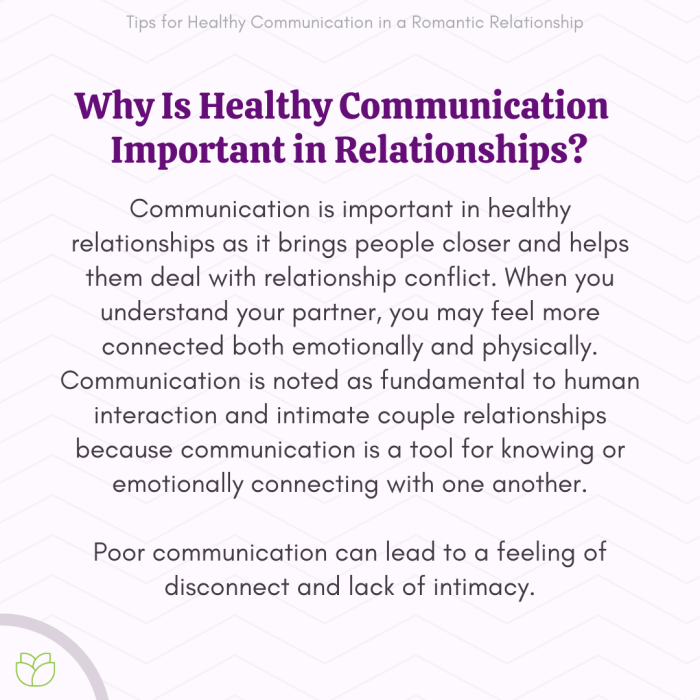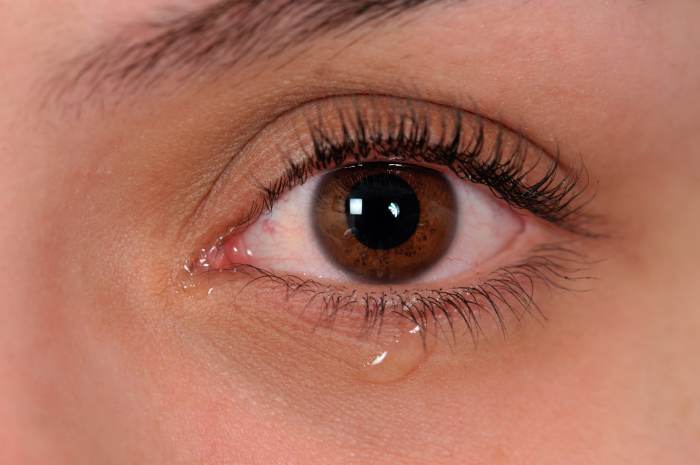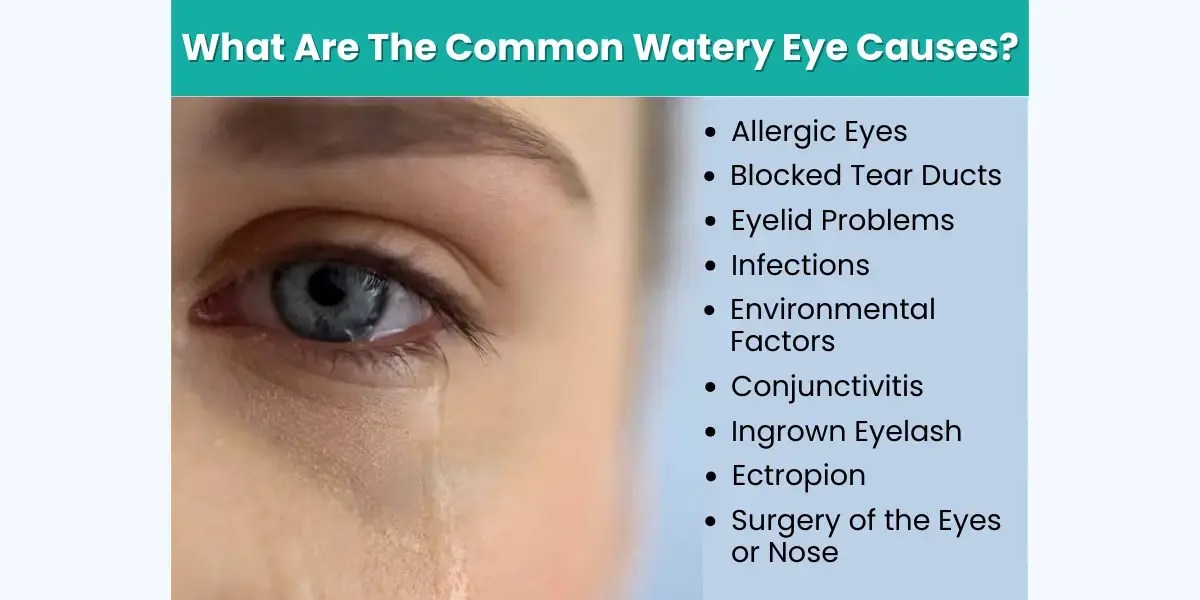Why do I have itchy eyes? This common problem can be frustrating, impacting daily life and comfort. From pesky allergies to more serious conditions, understanding the causes behind itchy eyes is key to finding relief. This guide delves into the various potential triggers, symptoms, and treatments, helping you pinpoint the source of your discomfort and take the right steps toward recovery.
Itchy eyes can be caused by a wide range of factors, from environmental irritants to underlying medical conditions. This comprehensive guide explores these causes, symptoms, and treatment options to help you better understand and manage your eye discomfort.
Potential Causes of Itchy Eyes
Itchy eyes are a common complaint, disrupting daily activities and often leading to discomfort. Understanding the underlying causes can help in finding effective solutions. This exploration will delve into environmental triggers, allergic and non-allergic reactions, the role of dry eye syndrome, and potential medical conditions.Many factors can contribute to itchy eyes, ranging from simple environmental irritants to more complex medical conditions.
Identifying the specific cause is crucial for developing the appropriate treatment strategy.
My eyes have been itching like crazy lately, and I’ve been doing some digging. Could it be related to my diet? I’ve heard that certain foods, like the ones listed in this helpful article about candida diet foods to avoid , can trigger inflammation, potentially leading to itchy eyes. I’m going to be really mindful of what I’m eating to see if that makes a difference in my eye discomfort.
Environmental Triggers
Environmental factors play a significant role in causing itchy eyes. Exposure to various substances can irritate the delicate tissues of the eyes, leading to discomfort and itching.
- Pollen: Airborne pollen from plants, particularly during spring and summer, is a common culprit for allergic reactions. Specific types of pollen, such as ragweed and grasses, are potent triggers for seasonal allergies, causing itchy eyes, runny nose, and sneezing.
- Dust and other airborne particles: Dust, smoke, and other airborne particles can irritate the eyes, causing them to itch. Exposure to construction sites, or areas with high levels of dust, can be particularly problematic.
- Pet dander: Pet dander, tiny flakes of skin shed by pets, can trigger allergic reactions in susceptible individuals. This can lead to itchy eyes, sneezing, and skin rashes.
- Smoke: Smoke from various sources, including cigarettes, wildfires, and industrial emissions, can irritate the eyes and cause itching.
- Air pollution: Air pollution, encompassing a variety of pollutants, can irritate the eyes and cause them to itch.
Allergic vs. Non-Allergic Reactions
It’s essential to distinguish between allergic and non-allergic reactions, as the treatment approaches differ. An allergic reaction is triggered by an immune response to a specific substance, whereas a non-allergic reaction is caused by direct irritation or environmental factors.
- Allergic reactions: Allergic reactions occur when the immune system overreacts to a harmless substance, called an allergen. The immune response releases histamine and other chemicals, causing inflammation and itching. Examples include pollen allergies, pet dander allergies, and certain food allergies.
- Non-allergic reactions: Non-allergic reactions, in contrast, do not involve an immune response. Instead, they are caused by direct irritation or environmental factors. Examples include exposure to dust, smoke, or wind, or even certain eye drops.
Dry Eye Syndrome
Dry eye syndrome is a common condition characterized by insufficient tear production or excessive tear evaporation. This imbalance in the tear film can lead to various symptoms, including itching, burning, and a gritty sensation in the eyes. Chronic dry eye can significantly impact the comfort and quality of life for individuals.
Potential Medical Conditions
Several medical conditions can cause itchy eyes. Diagnosing the underlying cause is crucial for proper management.
- Conjunctivitis: Inflammation of the conjunctiva, the thin membrane lining the inside of the eyelids and covering the white part of the eye, can manifest as itchy eyes, redness, and discharge. This condition can be caused by bacterial, viral, or allergic factors.
- Blepharitis: Inflammation of the eyelids can lead to itching, crusting, and redness around the eyes. This condition often involves the eyelashes and the glands within the eyelids.
Comparison of Allergic and Non-Allergic Eye Reactions
| Characteristic | Allergic Reaction | Non-Allergic Reaction |
|---|---|---|
| Symptoms | Itching, redness, watery eyes, sneezing, runny nose | Itching, burning, gritty sensation, redness |
| Triggers | Pollen, pet dander, dust mites, certain foods | Wind, smoke, dust, dry air, certain eye drops |
| Potential Treatments | Allergy medications (antihistamines, decongestants), avoidance of allergens, eye drops | Lubricating eye drops, artificial tears, environmental controls |
Symptoms Associated with Itchy Eyes

Itchy eyes are a common complaint, often accompanied by other symptoms that can provide clues about the underlying cause. Understanding these associated symptoms is crucial for accurate diagnosis and appropriate treatment. Identifying the specific combination of symptoms can help differentiate between various eye conditions and potential systemic issues.Beyond the simple sensation of itch, a range of additional symptoms can accompany the discomfort.
These symptoms can vary in intensity and severity, offering valuable insights into the nature of the problem. Careful observation of these accompanying symptoms can aid in determining the source of the irritation and guide the appropriate course of action.
Range of Symptoms Accompanying Itch
Itchiness isn’t the only sensation associated with irritated eyes. Commonly reported symptoms include burning, redness, and swelling. Burning sensations can range from a mild, persistent discomfort to a more intense, sharp pain. Redness, often visible as a flushed or pink coloration of the eye, is another frequent symptom, indicating inflammation in the delicate tissues of the eye. Swelling, characterized by puffiness or a noticeable increase in the size of the eyelids or surrounding areas, can also accompany itchy eyes.
The combination and intensity of these symptoms can vary significantly depending on the specific cause.
Comparison of Symptoms Across Eye Conditions
Different eye conditions can manifest with similar symptoms, making accurate diagnosis challenging. For example, allergic reactions and infections, while both causing itchy eyes, can present with varying degrees of burning, redness, and swelling. Allergies may be accompanied by a watery discharge, while infections might present with pus or a thick discharge. The presence of other symptoms, such as a stuffy nose or sneezing, can also help differentiate between these conditions.
Careful observation of the specific characteristics of the symptoms can assist in identifying the precise nature of the eye condition.
Symptoms Accompanying Other Health Concerns, Why do i have itchy eyes
Itchy eyes are sometimes associated with other health concerns that may seem unrelated at first. For example, a stuffy nose, sneezing, and a skin rash may accompany eye irritation, particularly in cases of allergies. These additional symptoms can point to systemic reactions, such as those triggered by pollen or other environmental irritants. It’s important to note that a stuffy nose and sneezing are also symptoms of viral infections, potentially affecting the eyes through the spread of pathogens.
Therefore, identifying other associated symptoms can be crucial for a comprehensive evaluation.
Variability of Symptoms Based on Underlying Causes
The symptoms associated with itchy eyes can vary significantly based on the underlying cause. For instance, a simple irritant, such as dust or smoke, may cause mild itchiness and redness, while a severe allergic reaction might produce intense itching, swelling, and even difficulty seeing. Similarly, an eye infection can present with a range of symptoms, including severe pain, redness, and a thick discharge, depending on the type and severity of the infection.
The presence and intensity of accompanying symptoms offer valuable insights into the severity of the condition.
Potential Severity Table
| Symptom(s) | Possible Severity |
|---|---|
| Itchiness, mild redness | Likely mild, possibly due to an irritant |
| Itchiness, redness, burning, mild swelling | Potentially moderate, suggesting an allergic reaction or infection |
| Itchiness, severe redness, swelling, difficulty seeing, pus/discharge | Potentially severe, indicative of an eye infection or more serious condition; medical attention is recommended |
| Itchiness, redness, swelling, accompanied by stuffy nose, sneezing, skin rash | May indicate an allergic reaction or systemic illness; further evaluation is necessary |
Home Remedies and First Aid for Itchy Eyes: Why Do I Have Itchy Eyes
Dealing with itchy eyes can be frustrating, but often, simple home remedies can provide relief. Understanding when to seek medical attention is crucial for managing the condition effectively and preventing potential complications. This section will explore various home remedies and emphasize the importance of responsible self-care.
My eyes have been itching like crazy lately. I’ve been wondering if it’s connected to my diet, and I’ve been reading up on the potential link between milk and arthritis, especially since I’ve been having a lot more dairy lately. It’s interesting to see the potential pros and cons of including dairy in your diet when dealing with joint pain.
Checking out resources like milk and arthritis pros cons and recommendations could give me some clues. Maybe it’s not the milk after all, but it’s definitely something I’ll need to investigate further to figure out why my eyes are acting up.
Simple Home Remedies for Mild Itchy Eyes
Mild cases of itchy eyes can often be managed at home. These remedies focus on soothing the irritated surface and reducing inflammation.
- Cold Compresses: Applying a cold compress to the affected eye can help constrict blood vessels and reduce inflammation. The cool temperature provides immediate relief from the itching sensation. A dampened washcloth or a chilled tea bag can serve as effective compresses.
- Lubricating Eye Drops: Dry eyes are a frequent cause of itchy eyes. Using lubricating eye drops can help restore moisture to the eye surface, reducing irritation and the itch. These drops are typically safe for most people and can be purchased over-the-counter. Always follow the instructions on the packaging.
- Avoiding Irritants: Identifying and avoiding irritants can be key to preventing future episodes. Common irritants include smoke, dust, pollen, and strong chemicals. If you suspect an irritant is the cause, try to eliminate it from your environment.
Safe and Effective Use of Eye Drops
Properly using eye drops is essential for ensuring their effectiveness and avoiding potential complications. Always follow the instructions on the packaging and ensure hygiene.
- Cleanliness is Paramount: Wash your hands thoroughly with soap and water before handling eye drops. This helps prevent introducing bacteria or other contaminants to your eyes.
- Proper Application Technique: Tilt your head back slightly and gently pull down the lower eyelid to create a small pouch. Place the prescribed number of drops into the pouch. Avoid touching the tip of the dropper to your eye or any surface.
- Follow Instructions: Always follow the recommended frequency and dosage as directed by the ophthalmologist or pharmacist. Using eye drops more frequently than prescribed may not provide additional relief and could potentially be harmful.
- Storage and Disposal: Store eye drops in their original packaging and in a cool, dry place. Discard any unused eye drops after the expiration date.
When to Seek Immediate Medical Attention
Some cases of itchy eyes require immediate medical attention. Symptoms that warrant an urgent visit to an eye care professional include:
- Severe Pain or Swelling: Intense pain or noticeable swelling around the eye could indicate a more serious underlying condition, such as an infection.
- Vision Changes: Any sudden changes in vision, such as blurry vision or double vision, require immediate medical evaluation. These changes could signal a significant problem that needs prompt attention.
- Discharge or Crusting: A discharge from the eye or the presence of crusting can be a sign of infection. It’s essential to consult a doctor for appropriate treatment.
- Redness that is Intense and Persistent: Prolonged, intense redness in the eye accompanied by other symptoms might point to a serious condition that requires immediate attention.
Potential Dangers of Self-Treating Severe Eye Conditions
Self-treating severe eye conditions can lead to serious complications. Incorrect treatment can worsen the underlying condition, potentially leading to permanent vision loss or other long-term health problems.
Ignoring severe eye issues can result in irreversible vision loss.
Step-by-Step Guide to Applying Cold Compresses
This step-by-step guide demonstrates how to apply a cold compress to soothe itchy eyes.
- Gather Materials: Obtain a clean washcloth or a cold compress, such as a chilled tea bag.
- Cool the Compress: Soak the washcloth in cold water or place the chilled tea bag in a bowl of ice water for a few minutes to ensure it’s cool enough.
- Apply Gently: Gently place the cool compress over the affected eye for a few minutes.
- Repeat as Needed: Repeat the application as necessary to help reduce inflammation and itching. Avoid applying ice directly to the skin, as it can cause damage.
Medical Treatments for Itchy Eyes

Dealing with itchy eyes can be frustrating, impacting daily activities and potentially signaling an underlying issue. Fortunately, various medical treatments are available to alleviate discomfort and address the root cause of the problem. This section will explore common over-the-counter and prescription medications, different types of eye drops, and diagnostic procedures for persistent itching.Understanding the different types of treatments available is crucial for managing itchy eyes effectively.
A proper diagnosis, combined with the right medication, can significantly reduce the discomfort and improve overall eye health.
My itchy eyes have been driving me crazy lately. I’ve been wondering if it’s a food allergy, or maybe something I’ve been touching. Could it be linked to the recent sliced deli meats listeria outbreak? sliced deli meats listeria outbreak That’s definitely something to consider, and I’m going to check my recent food intake carefully.
Maybe it’s just something else entirely. Either way, I’m going to keep an eye on it and try to figure out what’s causing this.
Over-the-Counter Medications
Over-the-counter medications are often the first line of defense against mild to moderate itchy eyes. These options typically target the allergic reactions or inflammation associated with the condition.
- Antihistamines: These medications, like diphenhydramine (Benadryl), work by blocking histamine, a chemical released during allergic reactions. Antihistamines can be taken orally or applied topically as eye drops. Oral antihistamines provide a broader effect on the body, while topical drops provide more localized relief.
- Mast Cell Stabilizers: These medications, such as cromolyn sodium, prevent mast cells from releasing histamine and other inflammatory mediators. They are particularly effective in preventing allergic reactions and are often used for chronic cases of itchy eyes.
Prescription Medications
For chronic or severe cases of itchy eyes, prescription medications may be necessary. These medications often address underlying conditions or provide more potent anti-inflammatory effects.
- Oral Medications: In cases where allergies are a significant factor, prescription oral antihistamines or corticosteroids may be prescribed. These medications can effectively manage more severe allergic reactions.
- Stronger Eye Drops: Prescription eye drops containing corticosteroids or other potent anti-inflammatory agents may be used for conditions such as allergic conjunctivitis or other inflammatory eye disorders. These drops provide a targeted approach, reducing inflammation and itching more rapidly.
Types of Eye Drops
A variety of eye drops are available, each with a different mechanism of action and potential side effects. Understanding these differences is essential for choosing the appropriate treatment.
- Mechanism of Action: Different eye drops target different aspects of the inflammatory process. Some, like mast cell stabilizers, prevent the release of inflammatory mediators. Others, like corticosteroids, directly reduce inflammation. Understanding how each drop works is crucial for selecting the most effective treatment.
- Potential Side Effects: While generally safe, eye drops can cause side effects, such as burning, stinging, or blurred vision. The severity and duration of these side effects can vary depending on the individual and the specific medication. It is important to carefully follow the instructions and monitor for any unusual reactions.
Diagnosing Persistent Itchy Eyes
Persistent itchy eyes require a thorough evaluation to determine the underlying cause. A comprehensive eye examination and medical history are essential steps in this process.
- Comprehensive Eye Examination: A skilled ophthalmologist will conduct a thorough examination of the eyes, including checking for visible signs of inflammation, infection, or other abnormalities. This may involve using special instruments to examine the structures within the eye.
- Medical History: Gathering a detailed medical history is critical to identifying potential triggers or contributing factors. The history should include information about any allergies, recent environmental changes, or other medical conditions that could be affecting the eyes.
Eye Drop Comparison Table
| Eye Drop | Ingredients | Intended Use |
|---|---|---|
| Allergy Relief Drops | Antihistamines (e.g., ketotifen) | Treating allergic conjunctivitis, reducing itching and redness |
| Mast Cell Stabilizer Drops | Cromolyn sodium | Preventing allergic reactions, reducing inflammation |
| Corticosteroid Eye Drops | Prednisolone acetate | Treating severe inflammation, reducing swelling and itching in inflammatory conditions |
| Lubricant Eye Drops | Hyaluronic acid | Providing moisture and relief for dry eye, which can contribute to itching |
Prevention Strategies for Itchy Eyes
Itchy eyes can be a frustrating and sometimes debilitating condition. While addressing existing symptoms is crucial, proactive measures to prevent future occurrences are equally important. By understanding the factors contributing to itchy eyes and implementing preventive strategies, you can significantly reduce the likelihood of discomfort and maintain good eye health.Environmental factors play a significant role in triggering itchy eyes.
Exposure to allergens, irritants, and environmental conditions can all contribute to this issue. Understanding these factors and taking steps to minimize exposure is key to prevention.
Environmental Factors and Minimizing Exposure
Many environmental factors can irritate the eyes, leading to itching. Dust, pollen, smoke, and strong winds can all contribute to eye dryness and irritation. Exposure to air pollutants, such as industrial fumes or chemical emissions, can also cause discomfort. To minimize exposure, consider wearing sunglasses during outdoor activities, particularly when pollen counts are high. Using air purifiers in your home can help filter out airborne particles.
Consider staying indoors during periods of high pollen or air pollution. Also, ensure proper ventilation in your home and workplace to reduce the buildup of irritants.
Importance of Good Eye Hygiene
Maintaining good eye hygiene is essential for preventing infections and maintaining overall eye health. Regularly washing your hands before touching your eyes is a simple yet effective measure. Avoid rubbing your eyes, as this can introduce bacteria and irritants. If you wear contact lenses, follow the manufacturer’s instructions carefully regarding cleaning and disinfection. Proper lens care helps prevent infections and associated discomfort.
Nutrition and Hydration for Eye Health
Proper nutrition and hydration are vital for supporting overall eye health and preventing dryness, which can contribute to itchy eyes. A diet rich in antioxidants, such as those found in fruits and vegetables, can help protect the delicate tissues of the eyes. Staying well-hydrated helps maintain the moisture balance in the eyes, preventing dryness and irritation. Include foods rich in vitamins A, C, and E in your diet, and drink plenty of water throughout the day.
Protecting Eyes from Irritants
Protecting your eyes from irritants is crucial for preventing itchy eyes. When working with chemicals or dust, wear appropriate eye protection, such as safety glasses or goggles. In the home, ensure proper ventilation when using cleaning products or other potentially irritating substances. Protect your eyes from the sun’s harmful UV rays by wearing sunglasses with UV protection.
Daily Habits for Itchy Eye Prevention
Consistent good habits can significantly reduce the risk of itchy eyes. These habits encompass a range of actions, all focused on maintaining healthy eyes.
- Regularly wash your hands before touching your eyes.
- Avoid rubbing or scratching your eyes.
- Use eye drops to maintain moisture, especially in dry environments.
- Keep your surroundings clean and free from dust and allergens.
- Wear sunglasses to protect your eyes from the sun’s harmful UV rays.
- Maintain a healthy diet rich in vitamins and antioxidants.
- Stay hydrated by drinking plenty of water.
- Use air purifiers in your home to filter out airborne irritants.
- If you wear contact lenses, follow the manufacturer’s instructions carefully.
- Avoid contact with known allergens or irritants.
When to See a Doctor
Itchy eyes, while often a minor nuisance, can sometimes signal a more serious underlying issue. Understanding when to seek professional medical attention is crucial for maintaining eye health and preventing potential complications. Ignoring persistent or worsening symptoms can delay diagnosis and treatment, potentially leading to vision problems or other health concerns.Knowing the specific warning signs and situations that warrant immediate medical intervention can save valuable time and ensure prompt treatment.
This section will Artikel the criteria for determining when professional medical care is required for itchy eyes, enabling you to make informed decisions about your eye health.
Identifying Urgent Situations
Prompt medical attention is essential in cases of severe or sudden onset symptoms, or when accompanied by other concerning signs. For instance, if the itchiness is accompanied by a sudden, sharp pain in the eye, a significant change in vision, or the appearance of pus or discharge, immediate medical care is critical. These symptoms could indicate a serious infection or injury requiring immediate treatment.
Importance of Professional Medical Advice
Persistent or worsening itchy eyes, even if initially mild, should prompt a visit to an ophthalmologist or optometrist. Symptoms that don’t improve with home remedies or over-the-counter medications may signify an underlying condition that requires professional diagnosis and treatment. Ignoring such symptoms could potentially lead to more significant issues in the long run.
Scheduling an Appointment
Scheduling an appointment with an ophthalmologist or optometrist involves contacting their office directly. This often involves providing your personal details, insurance information, and a brief description of your symptoms. They can then schedule an appointment that accommodates your availability. Remember to communicate any relevant medical history or medications you are currently taking.
Warning Signs of Potential Serious Eye Conditions
Certain symptoms strongly suggest a potential serious eye condition. These include persistent or recurrent blurry vision, sudden vision loss, severe pain, changes in the color or appearance of the eye, or a feeling of something being in the eye. Any combination of these symptoms warrants immediate attention from a healthcare professional.
When to Seek Immediate Medical Attention
| Symptom Category | Description | Action Required |
|---|---|---|
| Severe Pain | Intense, sharp, or throbbing pain in one or both eyes. | Seek immediate medical attention. |
| Sudden Vision Changes | Significant changes in vision, such as blurry vision, double vision, or sudden loss of vision. | Seek immediate medical attention. |
| Increased Sensitivity to Light | Unusual or excessive sensitivity to light, often accompanied by pain. | Seek prompt medical attention. |
| Discharge or Pus | Noticeable discharge or pus coming from the eye(s). | Seek immediate medical attention. |
| Visible Redness or Swelling | Significant redness or swelling around the eye(s), accompanied by pain or discomfort. | Seek prompt medical attention. |
| Redness with Severe Itchiness | Persistent and severe itchiness coupled with intense redness and inflammation. | Seek prompt medical attention. |
Last Point
In conclusion, itchy eyes, while often a minor inconvenience, can sometimes signal a more significant issue. Understanding the possible causes, from allergies to dry eyes, is crucial for effective management. By recognizing symptoms and exploring home remedies, over-the-counter treatments, and when to seek medical attention, you can take control of your eye health and find lasting relief. Remember, if your symptoms persist or worsen, consult an eye doctor for a proper diagnosis and personalized treatment plan.




